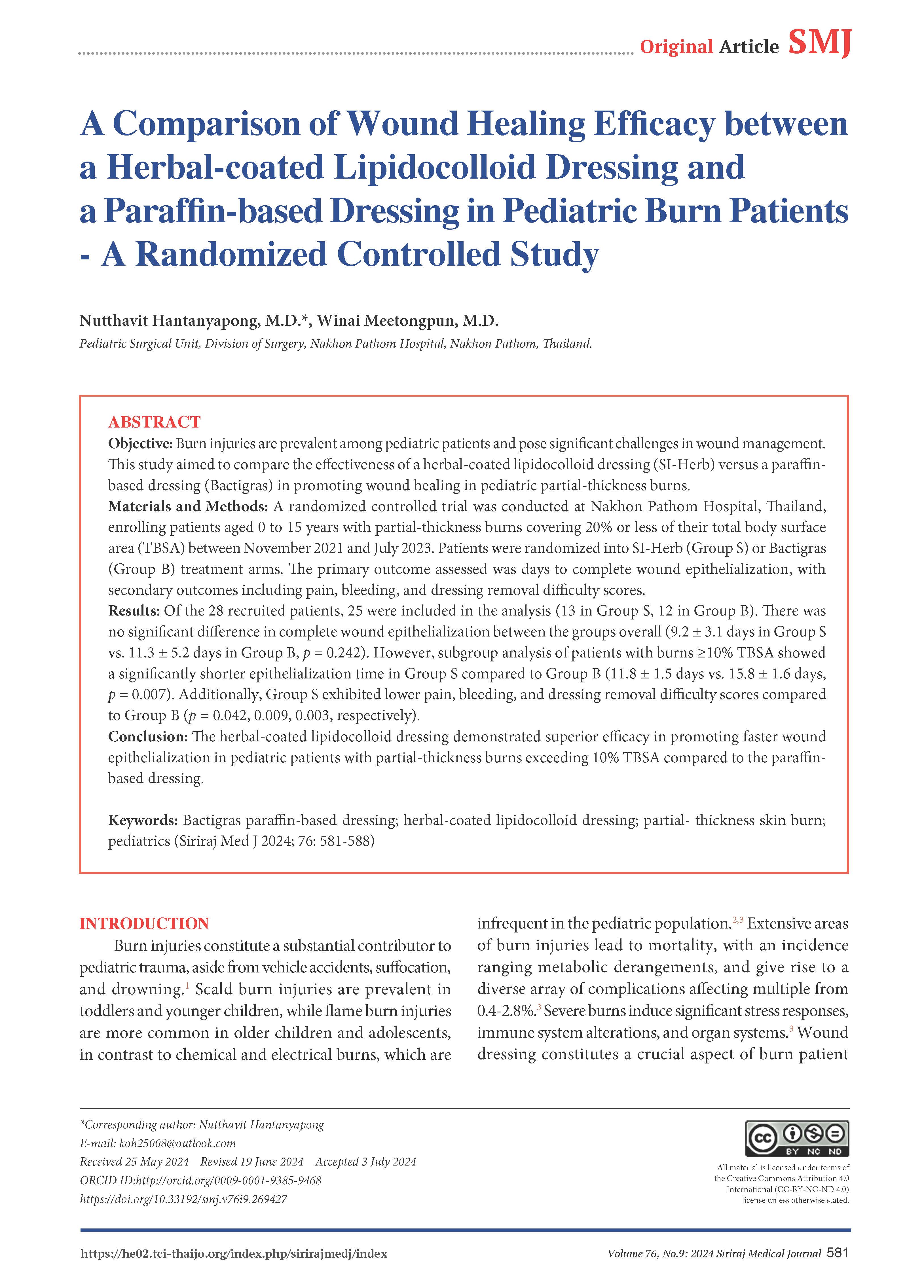A Comparison of Wound Healing Efficacy between a Herbal-coated Lipidocolloid Dressing and a Paraffin-based Dressing in Pediatric Burn Patients - A Randomized Controlled Study
DOI:
https://doi.org/10.33192/smj.v76i9.269427Keywords:
Bactigras paraffin-based dressing, Herbal-coated lipidocolloid dressing, pediatrics, partial thickness burnsAbstract
Objective: Burn injuries are prevalent among pediatric patients and pose significant challenges in wound management. This study aimed to compare the effectiveness of a herbal-coated lipidocolloid dressing (SI-Herb) versus a paraffinbased dressing (Bactigras) in promoting wound healing in pediatric partial-thickness burns.
Materials and Methods: A randomized controlled trial was conducted at Nakhon Pathom Hospital, Thailand, enrolling patients aged 0 to 15 years with partial-thickness burns covering 20% or less of their total body surface area (TBSA) between November 2021 and July 2023. Patients were randomized into SI-Herb (Group S) or Bactigras (Group B) treatment arms. The primary outcome assessed was days to complete wound epithelialization, with secondary outcomes including pain, bleeding, and dressing removal difficulty scores.
Results: Of the 28 recruited patients, 25 were included in the analysis (13 in Group S, 12 in Group B). There was no significant difference in complete wound epithelialization between the groups overall (9.2 ± 3.1 days in Group S vs. 11.3 ± 5.2 days in Group B, p = 0.242). However, subgroup analysis of patients with burns ≥10% TBSA showed a significantly shorter epithelialization time in Group S compared to Group B (11.8 ± 1.5 days vs. 15.8 ± 1.6 days, p = 0.007). Additionally, Group S exhibited lower pain, bleeding, and dressing removal difficulty scores compared to Group B (p = 0.042, 0.009, 0.003, respectively).
Conclusion: The herbal-coated lipidocolloid dressing demonstrated superior efficacy in promoting faster wound epithelialization in pediatric patients with partial-thickness burns exceeding 10% TBSA compared to the paraffinbased dressing.
References
Partain KP, Fabia R, Thakkar RK. Pediatric burn care: new techniques and outcomes. Curr Opin Pediatr. 2020;32(3):405-10.
Shah AR, Liao LF. Pediatric Burn Care: Unique Considerations in Management. Clin Plast Surg. 2017;44(3):603-10.
Strobel AM, Fey R. Emergency Care of Pediatric Burns. Emerg Med Clin North Am. 2018;36(2):441-58.
Dyster-Aas J, Kildal M, Willebrand M. Return to work and health-related quality of life after burn injury. J Rehabil Med. 2007;39(1):49-55.
Muangman P, Chuntrasakul C, Silthram S, Suvanchote S, Benjathanung R, Kittidacha S, et al. Comparison of efficacy of 1% silver sulfadiazine and Acticoat for treatment of partial-thickness burn wounds. J Med Assoc Thai. 2006;89(7):953-8.
Muangman P, Praditsuktavorn B, Chinaroonchai K, Chuntrasakul C. Clinical Efficacy Test of Polyester Containing Herbal Extract Dressings in Burn Wound Healing. Int J Low Extrem Wounds. 2016;15(3):203-12.
Murari A, Singh KN. Lund and Browder chart-modified versus original: a comparative study. Acute Crit Care. 2019;34(4):276-81.
Crellin D, Sullivan TP, Babl FE, O'Sullivan R, Hutchinson A. Analysis of the validation of existing behavioral pain and distress scales for use in the procedural setting. Paediatr Anaesth. 2007;17(8):720-33.
Tomlinson D, von Baeyer CL, Stinson JN, Sung L. A systematic review of faces scales for the self-report of pain intensity in children. Pediatrics. 2010;126(5):e1168-98.
Paddock HN, Fabia R, Giles S, Hayes J, Lowell W, Adams D, et al. A silver-impregnated antimicrobial dressing reduces hospital costs for pediatric burn patients. J Pediatr Surg. 2007;42(1):211-3.
Tianwattanatada S, Namviriyachote N, Chinaroonchai K, Owattanapanich N, Nair HK, Muangman P. Clinical efficacy test of polyester dressing containing herbal extracts and silver sulfadiazine cream compared with silver sulfadiazine cream in healing burn wounds: A prospective randomized controlled trial. Siriraj Med J. 2021;73(11):752-7.
Fabia R, Groner JI. Advances in the care of children with burns. Adv Pediatr. 2009;56:219-48.
Maenthaisong R, Chaiyakunapruk N, Niruntraporn S, Kongkaew C. The efficacy of aloe vera used for burn wound healing: a systematic review. Burns. 2007;33(6):713-8.
Khorasani G, Ahmadi A, Jalal Hosseinimehr S, Ahmadi A, Taheri A, Fathi H. The Effects of Aloe Vera Cream on Split-thickness Skin Graft Donor Site Management: A Randomized, Blinded, Placebo-controlled Study. Wounds. 2011;23(2):44-8.
Sharma S, Alfonso AR, Gordon AJ, Kwong J, Lin LJ, Chiu ES. Second-Degree Burns and Aloe Vera: A Meta-analysis and Systematic Review. Adv Skin Wound Care. 2022;35(11):1-9.
Paocharoen V. The efficacy and side effects of oral Centella asiatica extract for wound healing promotion in diabetic wound patients. J Med Assoc Thai. 2010;93 Suppl 7:S166-70.
Arribas-Lopez E, Zand N, Ojo O, Snowden MJ, Kochhar T. A Systematic Review of the Effect of Centella asiatica on Wound Healing. Int J Environ Res Public Health. 2022;19(6):3266.
Hekmatpou D, Mehrabi F, Rahzani K, Aminiyan A. The Effect of Aloe Vera Clinical Trials on Prevention and Healing of Skin Wound: A Systematic Review. Iran J Med Sci. 2019;44(1):1-9.
Gaglani A, Gross T. Pediatric Pain Management. Emerg Med Clin North Am. 2018;36(2):323-34.
Ramos G, Cornistein W, Cerino GT, Nacif G. Systemic antimicrobial prophylaxis in burn patients: systematic review. J Hosp Infect. 2017;97(2):105-14.
Csenkey A, Jozsa G, Gede N, Pakai E, Tinusz B, Rumbus Z, et al. Systemic antibiotic prophylaxis does not affect infectious complications in pediatric burn injury: A meta-analysis. PLoS One. 2019;14(9):e0223063.

Published
How to Cite
License
Copyright (c) 2024 Siriraj Medical Journal

This work is licensed under a Creative Commons Attribution-NonCommercial-NoDerivatives 4.0 International License.
Authors who publish with this journal agree to the following conditions:
Copyright Transfer
In submitting a manuscript, the authors acknowledge that the work will become the copyrighted property of Siriraj Medical Journal upon publication.
License
Articles are licensed under a Creative Commons Attribution-NonCommercial-NoDerivatives 4.0 International License (CC BY-NC-ND 4.0). This license allows for the sharing of the work for non-commercial purposes with proper attribution to the authors and the journal. However, it does not permit modifications or the creation of derivative works.
Sharing and Access
Authors are encouraged to share their article on their personal or institutional websites and through other non-commercial platforms. Doing so can increase readership and citations.














